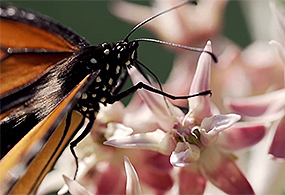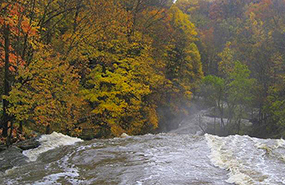More than beautiful, monarch butterflies contribute to the health of our planet. While feeding on nectar, they pollinate many types of wildflowers.
A Dangerous Beauty

NPS
More than beautiful, monarch butterflies contribute to the health of our planet. While feeding on nectar, they pollinate many types of wildflowers. The flowers they chose are varieties that are brightly colored, grow in clusters, stay open during the day, and have flat surfaces that serve as landing pads for their tiny guests. Monarch butterflies are also an important food source for birds, small animals, and other insects.
The vivid markings of the monarch butterfly (Danaus plexippus) serves as a “skull and crossbones” warning, signaling “Poison!” to the butterfly’s predators. Female monarchs lay their eggs on the underside of poisonous milkweed leaves. As the caterpillar hatches, it eats its own egg; then switches to a diet of milkweed leaves. The milkweeds’ toxins remain permanently in the monarch’s system, even after the caterpillar metamorphoses into a butterfly. Animals that eat a monarch become very sick and, thereafter, will avoid this distinctively patterned butterfly.
Far Extending and Wide Ranging

NPS
Monarch butterflies live mainly in prairies, meadows, grasslands and along roadsides, across most of North America. The adult butterfly drinks nectar from a variety of flowers, uncoiling and extending its long proboscis to sip food. When not in use, this flexible “tongue” coils back into a spiral.
Most monarchs will live only a few weeks, but the generation that emerges in late summer and early fall is different. These butterflies are born to travel and may live for eight or nine months to accomplish their lengthy migration. Scientists think the monarchs use the position of the sun and the changing weather to know when it’s time for their long journey.
Monarchs experience significant threats to their survival
- Loss of milkweed plants
Although monarchs feed on the nectar of many flowers, they lay their eggs only on certain types of milkweed plants. Unfortunately, milkweeds are often eradicated as noxious weeds. Urbanization, industrialized, large-scale farms, and drought conditions have also resulted in significant plant loss.
- Loss of winter habitat
The butterflies' winter habitat in Mexico and California is rapidly shrinking due to deforestation, harsh weather, development and other disruptions. Because all monarchs gather in only a few locations, the overall population is at risk.
- Climate Change
Especially during the last decade, changes in climate have resulted in more out-of-season storms, severe temperature drops and excessive rain. The combination of both wet and cold is deadly and has resulted in the deaths of hundreds of millions of butterflies.
Monarch Butterflies and National Parks

NPS
One of the greatest threats to Monarch populations is loss of habitat along the butterflies’ annual migratory routes. Important conservation efforts within parks include catching, identifying, and tagging monarchs to learn more about their population and migration status. Look for Monarch butterflies in Fire Island National Seashore, Great Smoky Mountains National Park, Cuyahoga Valley National Park, and Zion National Park and many others.
Feature Video
Monarchs & Milkweed - Yosemite Nature Notes - Episode 24
Take a microcosmic safari through a field of milkweed and discover a whole world of life, from bees to wasps to hummingbirds to butterflies. The charismatic Monarch butterfly is completely dependent on milkweed for its survival, and places like Yosemite National Park offer protection for this often overlooked plant.
Last updated: June 20, 2025
